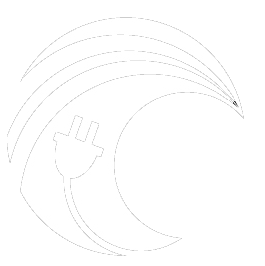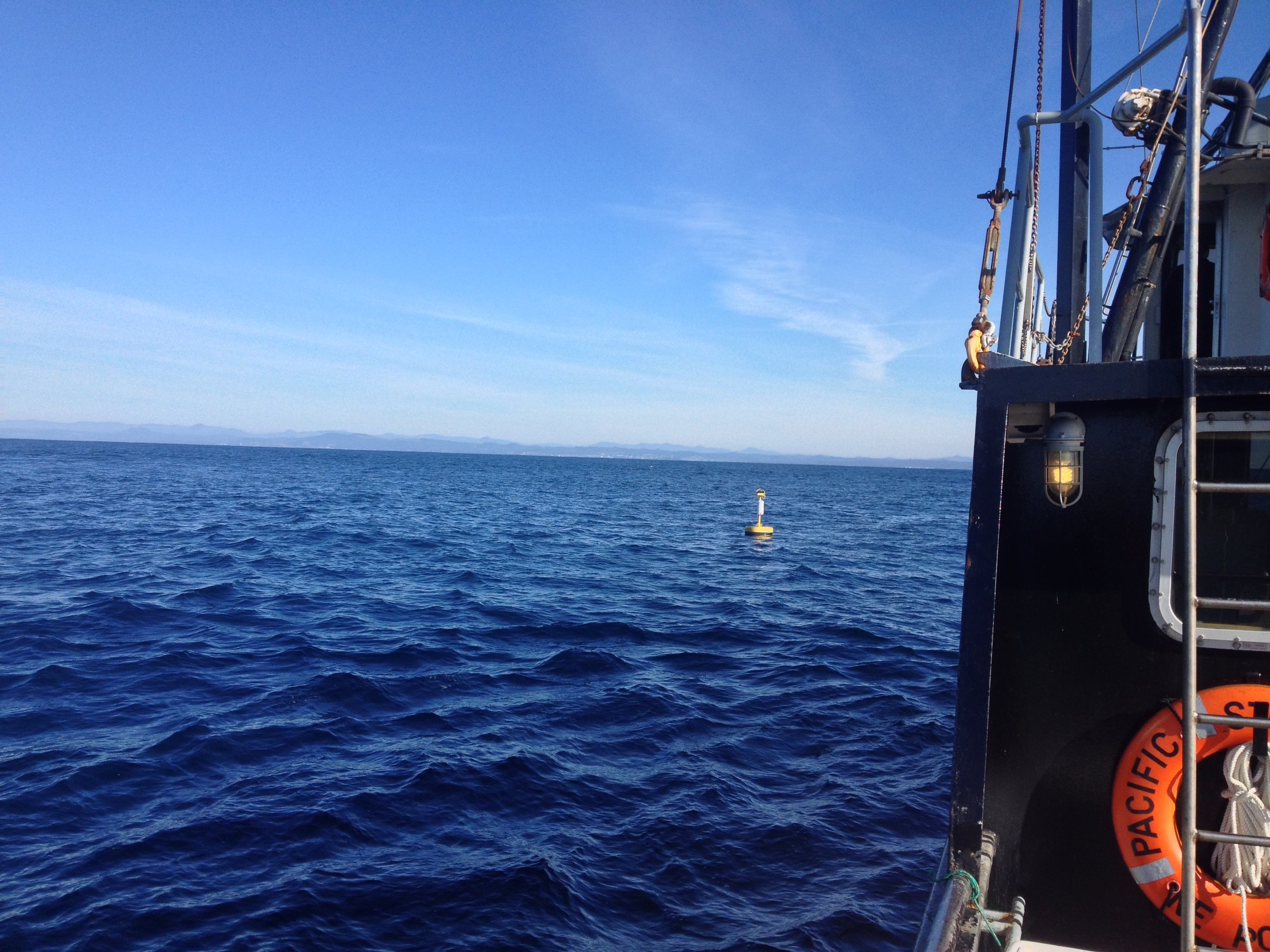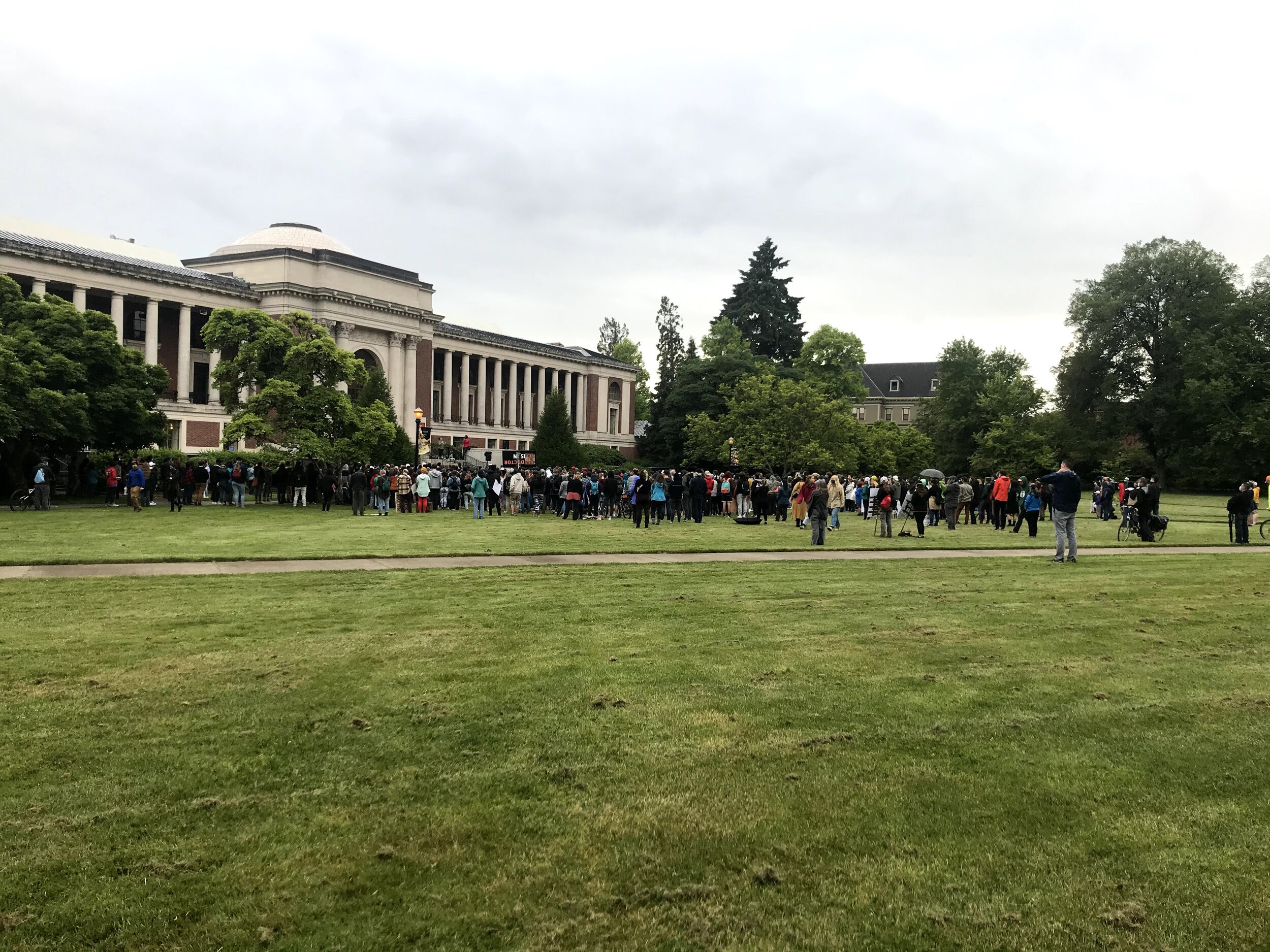Black Lives Matter Protests outside of Memorial Union at Oregon State University
Thesis Series: Hannah Ross on Scaling Effects and Hydrodynamic Performance of tidal turbines
03 July, 2020
By Ali Trueworthy
Like so many other graduate students around the world this Spring, Hannah Ross gave her PhD Dissertation via Zoom. Not only did she present years of work in a mere 50 minutes, but she did so to a screen. Reviewing her dissertation, one can’t help but be amazed by this feat. Hannah’s work spans the theoretical, the computational, and the experimental, all with the goal of improving the scientific understanding of the scaling effects and hydrodynamic performance of tidal turbines. A tidal turbine designed for grid connection could be up to 15 meters in diameter. Think about trying to test something that big! It would be expensive and time consuming. To reduce that expense, designers need to use computational models or to test smaller versions of their turbines. Any computational models must be validated with experimental results. The challenge of testing smaller versions of tidal turbines is understanding how the important measures of turbine performance, such as power output, scale as the turbine gets smaller. By understanding that, researchers and developers can make accurate estimates of the performance of full-sized turbines.
Model tidal turbine in the Bamfield Marine Sciences Centre Fluid Dynamics Lab in 2017. PC: Noah Johnson
In her most recent work, Hannah determined the impact of the blockage ratio, Reynolds number, and Froude number on turbine performance. This work, she said, was the most rewarding of her PhD. It allowed her to “take a step back and look at the fundamentals.” Hannah began this work due to problems she was having with some other experiments. She had been running experiments and getting inconsistencies in the results, so she set out to understand why. She determined that, when experimenting with a model turbine, one not only has to control the blockage ratio, Reynolds number, and Froude number, but also the water temperature, flow speed, channel depth, turbine height, and submergence depth. With such excellent experimental capabilities at the University of Washington, Hannah was able to control each of these parameters, and thereby understand the importance of holding them constant during experimental testing and account for their impacts in computational modeling.
Hannah working on a tidal turbine experiment in the Bamfield Marine Sciences Centre Fluid Dynamics Lab in 2017. PC: Noah Johnson
Another aspect of her work that Hannah found to be particularly exciting was the mathematical and experimental work she did to evaluate blockage corrections. Blockage corrections are numerical operations performed on experimental results to account for the change in water flow due to the confinement of experimental tests. The walls of flumes or water tunnels where experimental testing is usually performed impact how the water moves past the turbines, and thereby, the turbine performance. When Hannah began her work evaluating blockage corrections, she noticed that there were quite a few different published options. By understanding where each correction came from and how they were applied, Hannah was able to see that many of the theories were based on the same set of equations. She said, “doing the math and putting it all together added clarity to the relationships between them all.” For this part of her dissertation, Hannah got to compare results from her experiments in the University of Washington flume to experiments completed in the much larger tow tank at the University of New Hampshire.
Thesis Series: Chris Dizon on a MiniDAQ system for wave energy converters (WECs)
PMEC student Chris Dizon set out at the beginning of his Master’s program to shrink the size and cost of data collection on WECs and put all of the commonly used sensors for onto one, simple platform. He presented the platform, called the MiniDAQ (DAQ for Data Acquisition System), in his Master’s Thesis defense in August of 2019.
Thesis Series: Emma Cotter on Using Machine Learning to Measuring Environmental Interactions of Marine Energy Devices
Geometry and Control Optimization: Lending Improved Understanding to Early Stage Design
02 August 2019
By Ali Trueworthy
Imagine jumping into a lake, pool, or the ocean. As you hit the water, you go under quite a bit further and faster if you pencil dive than if you belly flop. Just as your size and shape, what a researcher might call your “geometry,” impact how you move through water, so does a wave energy converter’s. Oscillating body wave energy devices are a type of wave energy converter (WEC) that collect energy from the relative motion between separate parts of the device. The size and shape of the device and the implementation of its control system dictate how it moves through the water, and therefore how much energy it can collect along the way.
In Reference Model 3, the buoyant float moves up and down with incoming waves while the center shaft remains still. The model was created by rearchers at the National Renewable Energy Lab and Sandia National Labs for WEC-Sim.
There are many options for the size and shape of such a device and its control systems. Hannah Mankle, a graduate student with Professor Bryony DuPont in Mechanical Engineering at Oregon State University, works with researchers from Sandia National Laboratory to help determine the optimal size, shape, and control system for maximum power conversion. To do so, Hannah uses optimization algorithms.
An optimization algorithm uses results from numerical models to test different sizes, shapes, and control systems to find the one that satisfies the “objective.” In Hannah’s work this means the WEC produces the most power at the lowest cost, which is represented by an LCOE, levelized cost of energy, approximation.
Previous work has been done to optimize geometry or controls, but Hannah’s work will be the first to optimize the two together. The numerical models simulate the WEC’s hydrodynamics and mechanical response to passing waves to predict the power output of a particular device. Within the optimization algorithm, the WEC size (and eventually shape) is selected and passed to an evaluation step, which optimizes the control for that given geometry to provide a power output. The result is used by the optimization algorithm to decide the next size (and shape) to select.
It would take a long time to test every possible combination of size, shape, and control scheme, so Hannah is testing four algorithms to see which can produce the highest quality solution in the least amount of time. Each algorithm uses a different method of choosing the next solution to test, attempting to arrive at the best one as quickly as possible without testing every combination.
Diagram shows the many inputs and numerical models used in Hannah’s Optimization Algorithm which include Boundary Elements Methods (BEM), which indicate how a device responds to wave action and an evaluation step which includes controls optimization. The controls optimization was developed by researchers at Sandia National Lab.
To test each algorithm, Hannah is starting by performing size optimization without various shapes. She is confident that the optimal WEC size will “butt up against the constraints” when looked at independently. In other words, she already knows the largest size will probably produce the best results, but the single objective optimization is a necessary first step for validating previous work and comparing optimization methods. She is excited to move forward and add in varying shapes.
The options for the shape of the WEC will be defined by a curve radially rotated about a center point. The curve is referred to as a spline, a shape which can be found in a lot of drawing software and is created using multiple mouse clicks- one per vertex. For the first iterations, the WEC model Hannah will use is a standard point absorber, known as Reference Model 3, and she’s optimizing the shape of the float section.
Hannah Mankle is a Masters student in Mechanical Engineering at Oregon State University. She is a part of the Design Engineering Lab and started her research in wave energy as an undergrad in 2017.
Hannah’s research will help researchers and developers understand the relationship between geometry and controls, and how geometry effects performance. As her team moves forward, she hopes to include more variables for geometry and controls, guiding early design decisions for the best possible wave energy converters.
Turbines and Turbulence at UAF
Nonlinear Control for Wave Energy Converters: getting the power we want, when we want it
PMEC Students and Faculty Attend Water Power Week in Washington D.C.
The 2019 International Marine Renewable Energy Conference (IMREC) was hosted in Washington D.C. last week alongside the National Hydropower Association’s annual conference and the Marine Energy Technology Symposium (METS). The event was an excellent opportunity for PMEC researchers from OSU, UW, and UAF to convene and share their work, both among each other and across the marine energy field at large.
PMEC - The Promise of the Ocean, the Challenge of the Problem, and the Blending of Disciplines
An individual may never be an expert in marine energy. There are plenty of experts working in the field, but they are experts in hydrodynamics, acoustics, control systems, design, oceanography, coastal dynamics, sociology, community dynamics, marine biology, naval engineering, mechanics, robotics, natural resource management, or one of many other disciplines which make up the community here at PMEC. That’s right, they are all here - and that is what makes PMEC so special.
Wave Energy Prize winners, Aquaharmonics, test wave energy converter at O.H. Hinsdale Wave Research Laboratory
After 11 days of testing in the O.H. Hinsdale Wave Research Lab (HWRL), Alex Hagmuller and Max Ginsburg of Aquaharmonics left with high hopes. The team of Oregon State University graduates is testing a 1/20th scale version of the device concept that won the U.S. Department of Energy’s Wave Energy Prize.










